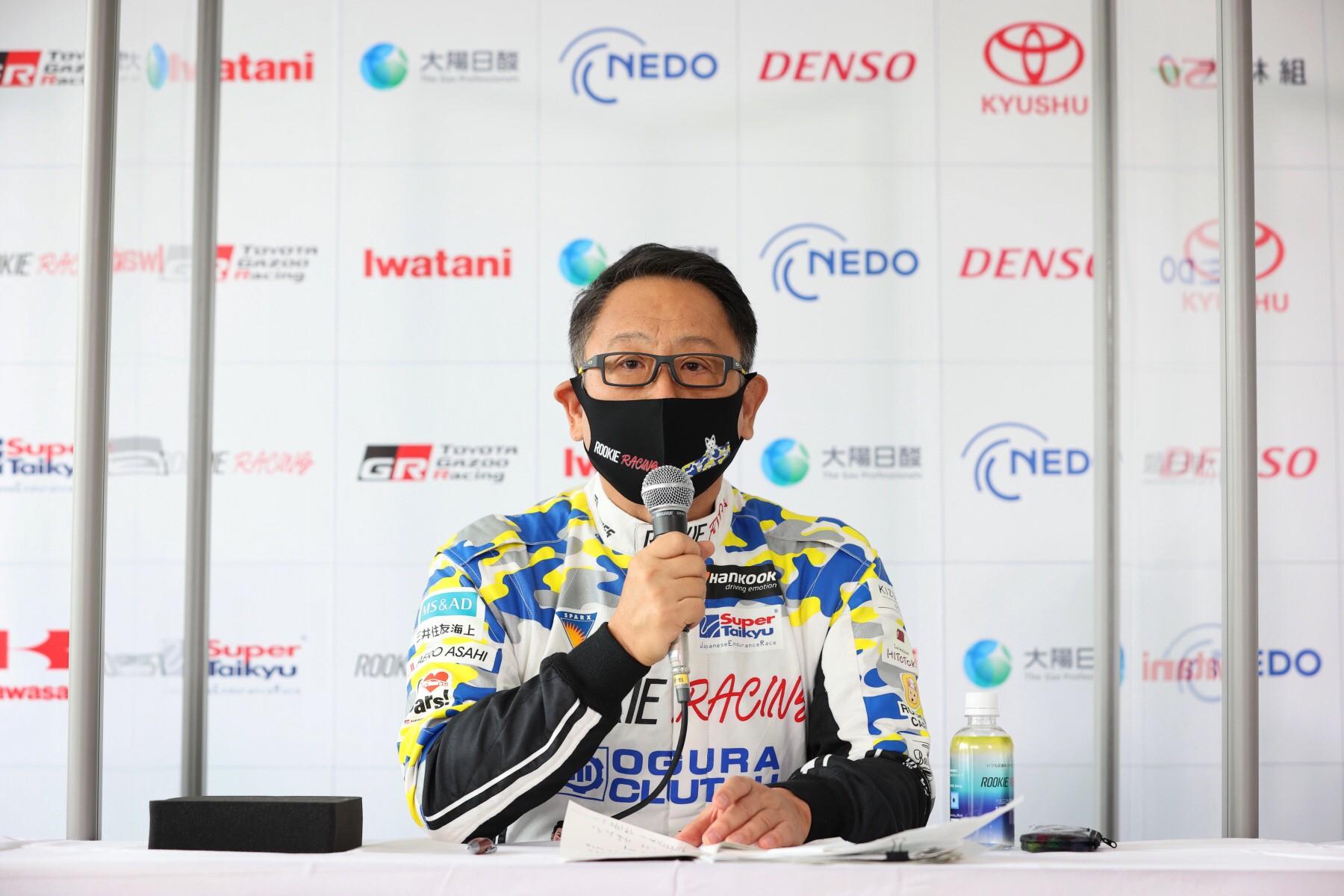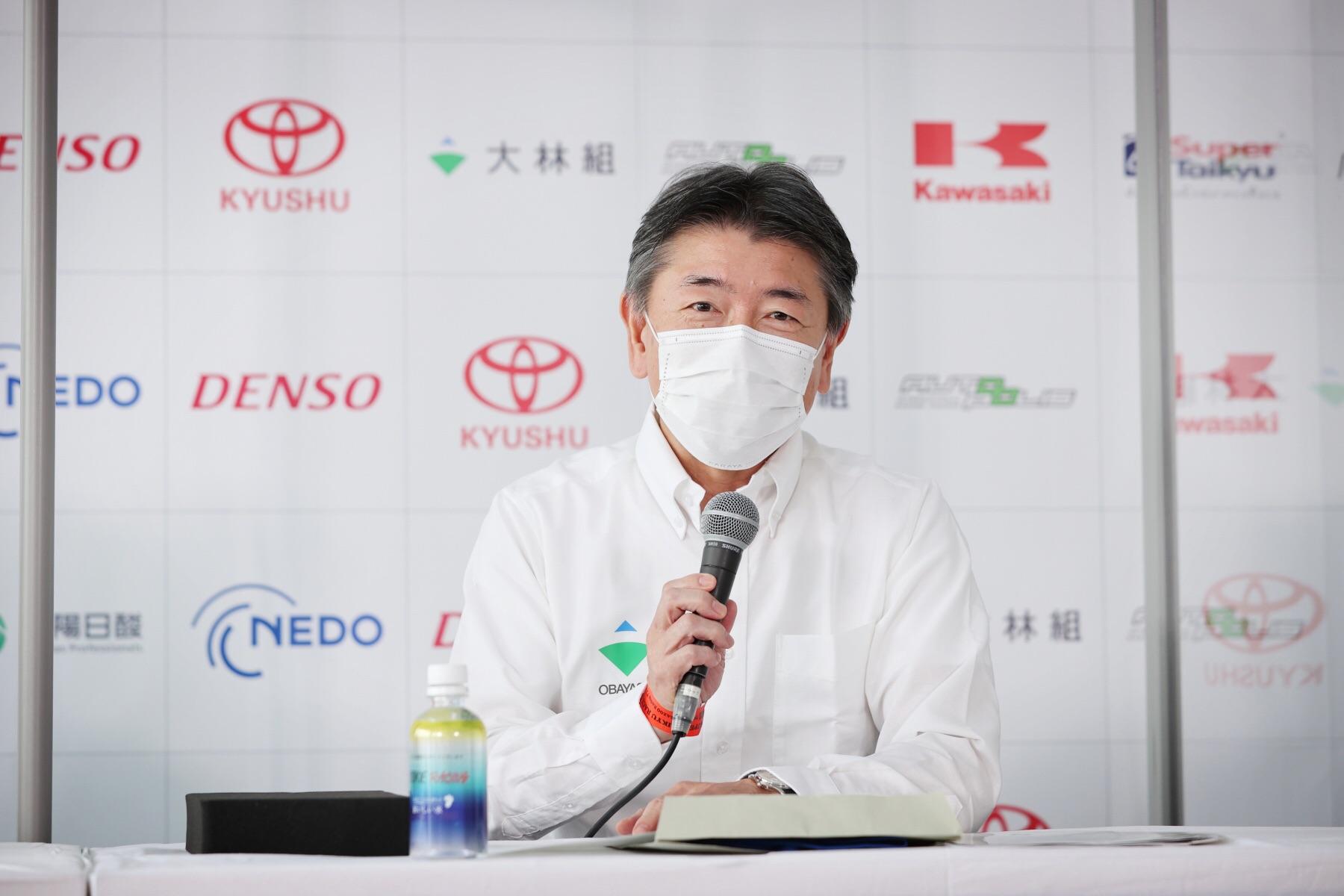
Fueled with locally produced green hydrogen, the hydrogen-powered engine expands renewable energy options in its second race.

On August 1, the fourth round of the 2021 Super Taikyu Series was held at the Autopolis circuit in Hita, Oita prefecture. Toyota’s Corolla Sport powered by hydrogen-fueled engine completed the five-hour main race without trouble.

This race marked the hydrogen engine car’s second appearance in competition, following May’s 24-hour race at Fuji Speedway (Oyama, Shizuoka prefecture). At a press conference the day before the race, President Akio Toyoda, who is also one of the hydrogen-powered Corolla’s drivers, conveyed the significance of this challenge.
Akio
I believe carbon neutrality is something we need to tackle across all industries, from producing and transporting energy to using it. If our previous effort helped to expand automobile technology options on the “using” side, I think this time will do the same for renewable energy options (on the “producing” side).

Half of the hydrogen used in this race was produced in Kyushu, an example of locally made fuel for local consumption. This carbon-free hydrogen was created through the combined efforts of Obayashi Corporation and Toyota Motor Kyushu (Toyota Kyushu).
Obayashi Corporation: Converting to hydrogen expands energy use
Oita is famous for its hot springs. According to a 2020 report on Japan’s sustainable zones by Chiba University’s Kurasaka Laboratory and the NPO Institute for Sustainable Energy Policies, the prefecture ranks first nationwide in the supply of geothermal power.
Oita is also one of Japan’s most progressive prefectures in terms of renewable energy use, ranking second only to Akita in self-sufficiency across all renewable sources.
In the Oita town of Kokonoe, Obayashi Corporation, a leading construction company, runs Japan’s first hydrogen production plant powered by geothermal energy. This plant supplied 30 percent of the hydrogen used in this race.
The hydrogen is made by electrolyzing water in processing equipment powered by electricity obtained from geothermal energy. Because all the electricity is generated in this way, the resulting green hydrogen is made entirely with renewables.
The plant has a production capacity of 1kg per hour (10Nm3/h). This means that the 5.6kg of hydrogen needed to fully refuel a fuel cell electric vehicle Mirai can be produced in around five and a half hours.
At present, five companies have expressed an interest in using the hydrogen, including Toyota Kyushu, which plans to use it in fuel cells and FC forklifts, and hydrogen fueling stations in the Kyushu area.
Whereas power generated from natural energy is affected by the weather, geothermal energy offers the advantage of a stable electricity supply. What’s more, in terms of geothermal energy resources, Japan’s potential is the third-largest in the world, after the U.S. and Indonesia.
However, these resources are not being effectively utilized, with the country ranking tenth in power generation capacity. This is because such infrastructure faces numerous hurdles, including negotiations with local communities, clashing interests with national parks in resource-rich areas, and long lead times before electricity is obtained.
These same circumstances also lay behind Obayashi's efforts to produce hydrogen.
Obayashi Corporation President Kenji Hasuwa
How do we transport and distribute the generated power? Not only for geothermal power, but the most orthodox way to distribute it is to connect it to the grid established by power companies.
However, due to the grid’s vulnerability and other issues, at times we are unable to distribute the electricity we have generated with renewable energy.
Given the situation, we figured that we could contribute to a sustainable future society by converting that electricity to hydrogen. Eyeing its potential as an (energy) carrier, we took on the challenge of creating hydrogen by electrolyzing water.

In fact, the area where the plant is located had already been scouted for hot springs by a local company hoping to generate geothermal power. However, the company was unable to carry out the project because of difficulties in obtaining permission to extend a main line to the area.
Through Obayashi’s efforts this time, the energy gained from geothermal sources can now be supplied around Kyushu. Locals have welcomed the project for having “created new added value (other than hot spring baths) from our geothermal energy.”
At a press conference, Obayashi President Kenji Hasuwa spoke about the significance of using the produced hydrogen for racing.
President Hasuwa
One of our concerns until now was finding places where the hydrogen would be used. Then we were approached by Toyota Kyushu, which began supplying it to hydrogen refueling stations and using it as fuel for the hydrogen-powered engine.
We were truly honored and delighted to have made this possible, and the project served as a great motivation boost for our engineers and other staff. We hope to continue growing into the future as we work to resolve cost issues and other challenges.
Toyota Kyushu: Solar power for 1,000 households
Toyota Kyushu’s Miyata Plant is located in Miyawaka City in Fukuoka Prefecture. Twenty percent of the hydrogen used in the race was made by electrolyzing water using electricity generated by solar panels on the plant’s roof.
This hydrogen is normally used to fuel the FC forklifts that carry materials around the plant, as well as for stationary fuel cells used for lighting and the hot water supply.
This system was introduced in 2016, marking Japan’s first effort to build an integrated system for producing and utilizing hydrogen from renewable energy.
Currently, the plant has the capacity to generate 3,900kW of electricity with its solar panels, enough to power 1,000 households.
For hydrogen, the plant’s production capacity is 2kg per hour (24Nm3/h), or enough to refuel one Mirai every 2.5 to 3 hours. The produced hydrogen is stored in tanks and sent through pipelines to on-site refueling equipment and stationary fuel cells.
Currently, the plant has 16 FC forklifts (see this article for examples of FC forklifts being used at other facilities). Such forklifts can run for five hours on a single refuel within five to 10 minutes, which uses 1.2kg of hydrogen, and be back at work.

Although FC forklifts make up less than 10 percent of the plant’s forklifts, their performance and maneuverability differ little from regular battery-powered lifts*.
*While battery-powered lifts take six hours to charge, the batteries can be replaced in around 10 minutes. With a battery weighing around 500kg, however, lifts are also required in the replacement process itself.
Because solar power generation is subject to the weather, Toyota Kyushu stabilizes the supply by converting electricity into hydrogen, making it easier to store (see this article for the advantages of hydrogen as an energy store).
To build on the use of green hydrogen in Toyota plants, Toyota Kyushu also plans to utilize the hydrogen produced by Obayashi Corporation. Toyota Kyushu President Osamu Nagata expressed his enthusiasm at the pre-race press conference.
President Nagata
I am very excited that the hydrogen we have produced will be used in the hydrogen-powered Corolla. We will continue to work with Obayashi Corporation and other companies to bring more people on board in producing and using hydrogen.

The Growing circle of carbon neutrality
Following on from the race at Fuji Speedway, this time sees the addition of new partners in the production of hydrogen. By taking place through motorsports rather than regular testing, these efforts towards creating a carbon-neutral society have drawn a great deal of attention.
At the press conference, Akio emphasized the importance of working together with like-minded partners, saying, “Carbon neutrality is for the benefit of the earth, for our world, and for the future, so we need like-minded people to come together”.
President Hasuwa followed on by saying, “If we can demonstrate (that geothermal power creates a win-win relationship with local communities), we may be able to generate momentum for working together in places where people had previously been hesitant”.
President Nagata also expressed his hopes and aspirations for the project, saying, “To address the challenge of lowering costs, we need collaboration between industry, academia, and governments. We want to move forward by drawing on expert knowledge”.
For the next race in Suzuka, the team plans to add another partner, Kawasaki Heavy Industries, on the side of transporting hydrogen from Australia.
Like Akio has often said recently, as the “purposeful passion and action” of private companies resonate with each other, the circle of hydrogen continues to grow. At the press conference, when asked about the action he would like to see from the Japanese government, the president answered with zeal.
Akio
First is getting more like-minded people in Japan. The second point is to properly understand carbon neutrality. And third, ensure that the paths towards achieving it are taken in the right order. I think it comes down to these three things.
If I may add to that third point, our adversary in carbon neutrality is carbon. I certainly don’t believe it is the internal combustion engine. In the current order of things, however, many people enthusiastically present internal combustion engines as the enemy. I feel that we’ve yet to find the right answer.
In times like these, rather than narrowing down options and acting as if we’ve found the solution, we need to explore many alternatives. There’s no telling where possibilities await, so I’d like to ask for support in pursuing them.


